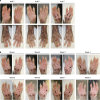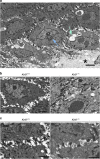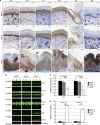Keratin 9 is required for the structural integrity and terminal differentiation of the palmoplantar epidermis
- PMID: 23962810
- PMCID: PMC3923277
- DOI: 10.1038/jid.2013.356
Keratin 9 is required for the structural integrity and terminal differentiation of the palmoplantar epidermis
Abstract
Keratin 9 (K9) is a type I intermediate filament protein whose expression is confined to the suprabasal layers of the palmoplantar epidermis. Although mutations in the K9 gene are known to cause epidermolytic palmoplantar keratoderma, a rare dominant-negative skin disorder, its functional significance is poorly understood. To gain insight into the physical requirement and importance of K9, we generated K9-deficient (Krt9(-/-)) mice. Here, we report that adult Krt9(-/-)mice develop calluses marked by hyperpigmentation that are exclusively localized to the stress-bearing footpads. Histological, immunohistochemical, and immunoblot analyses of these regions revealed hyperproliferation, impaired terminal differentiation, and abnormal expression of keratins K5, K14, and K2. Furthermore, the absence of K9 induces the stress-activated keratins K6 and K16. Importantly, mice heterozygous for the K9-null allele (Krt9(+/-)) show neither an overt nor histological phenotype, demonstrating that one Krt9 allele is sufficient for the developing normal palmoplantar epidermis. Together, our data demonstrate that complete ablation of K9 is not tolerable in vivo and that K9 is required for terminal differentiation and maintaining the mechanical integrity of palmoplantar epidermis.
Figures





References
-
- Candi E, Schmidt R, Melino G. The cornified envelope: a model of cell death in the skin. Nat Rev Mol Cell Biol. 2005;6:328–340. - PubMed
-
- Chan YM, Ka-Leung Cheng D, Nga-Yin Cheung A, et al. Female urethral adenocarcinoma arising from urethritis glandularis. Gynecol Oncol. 2000;79:511–514. - PubMed
-
- Cook HC.1974Manual of Histological Demonstration TechniquesButterworths, London, 314p.
-
- Coulombe PA, Tong X, Mazzalupo S, et al. Great promises yet to be fulfilled: defining keratin intermediate filament function in vivo. Eur J Cell Biol. 2004;83:735–746. - PubMed
Publication types
MeSH terms
Substances
Grants and funding
LinkOut - more resources
Full Text Sources
Other Literature Sources
Molecular Biology Databases
Research Materials

